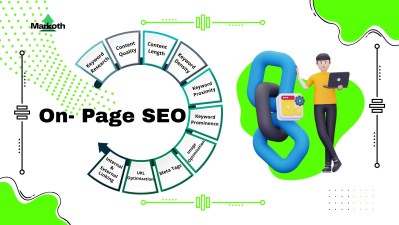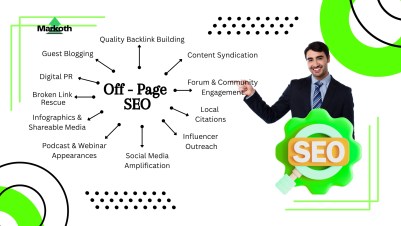What is SEO and How it Works?
Your competitors are growing their website on top in local or international on the organic level. Do you know how? Because of SEO. If you’re trying to scale the traffic, but no effort works!
Let’s read the article where you will understand what is seo and how it helps to rank any website on search engines.
What is SEO?
SEO, stand by Search Engine Optimization, which is a technical word for the non-digital marketing industry person. But very powerful to generate organic visitors on any website. SEO evaluates when search engines like Google, Bing, Yahoo, and other search engine platforms exist.
Many websites out there explain search engines in their languages. But wait, What do you understand about SEO in your term? Drop the little words at the end of it.
Let’s know what definitions are said by Big experts of the industry for SEO. Search engine optimization is the best practice to increase the organic visitors on a website by improving site’s user experience, functionality, relevant keywords, relevant topics and many other practices.
For simple language; SEO is a practice to optimize the website from every angle, either technically or non-technically, to match the criteria of search engine algorithm to rank higher position, although it will rank on search engine.
Search Engine Optimization and their types
Like every other matter, seo also has their types, which is three in counting.
- ON-Page SEO
- OFF-Page SEO
- TECHNICAL SEO
Before we start about their types, let’s confirm something about all of these. In some cases of practices in websites, ON-Page SEO, and Technical SEO are working with the same intent to become the same types of SEO.
Part 1 — On-Page SEO

On-Page SEO is the first type of SEO, which is used to practice on-site or within the website’s pages. It is also called On-Site SEO. On-Page SEO covers many parts involved while optimization of any website under it.
Circle image of ON-page seo points.
- Keyword Research
- Content Quality
- Content Length
- Keyword Density
- Keyword Proximity
- Keyword Prominence
- Image Optimization
- Meta Tags
- URL Optimization
- Internal Linking & External Linking
Keyword Research
Keyword research is the first step you should take before writing website content to target the right audience and topics. For example; If you are going to write any content on topics like “Best Dentist in Mumbai”. Your first priority is to research the relevant keywords for these topics. Draft them in a document and start writing.
Content Quality
Content Quality is always the king of any content over quantity unless it’s no use. So, before writing any content like Articles, Blogs, and Page Content. Research the relevant topics and add the more information that they haven’t provided in their content.
Write the high quality of content that makes your user satisfied, and remind them to visit your site again. Google favors websites that publish original, high-quality content that demonstrates expertise, credibility, and authority in their subject matter.
Content Length
Content length matters in On-page seo, if you’re writing any content for a website make sure the length of content is higher than the 900 words at least. This will happen when you cover detailed content for the relevant topics, which is favored by search engines.
Keyword Density
Keyword Density is the technical word of On-Page SEO. where while optimization of content, stuff the 1% of keyword or less of the whole word count in the content. Or you can use it naturally so that this will not count in spammy content.
Keyword Proximity
Keyword proximity is the term applied when you do not repeat your focus keyword again and again. In simple terms, keyword proximity means how close two or more keywords are placed to each other in your content.
For example; Best Nike shoes in Delhi is your focus keyword and you are proximate this keyword by adding a new word between the same intent. If you are looking for the best Nike shoes in chandni chowk of Delhi, visit here! Kind of example is best fit for keyword proximity.
Keyword Prominence
Keyword Prominence is a term to show the importance of a keyword in the web content or blog content. The primary keyword should appear at the beginning of your content, ideally within the first paragraph, to enhance SEO effectiveness.
Image Optimization
Image is an important role of any content. Without an image in a page it will look like no leaves on the trees. Optimizing the image is the crucial part. Design the image based on what your topics are about. The size of the image should be under kilobytes (kbs).
Meta Tags
Meta tags offer supplementary details about a webpage’s content, helping search engines understand and display it accurately in results. You can view it in source code by clicking right on the mouse and inspecting it or directly click on the web-page and press Ctrl+U. You will find Meta tags within <html>.
Like; <meta name=”description” content=”A mini description of the content”>,
<meta name=”Keyword” content=”focus keyword, Primary keyword, secondary keyword”>,
<meta name=”rating” content=”4.5 Stars”>
URL Optimization
The URL Optimization is a process where we optimize the url based on user friendly and search engine friendly, and keyword oriented.
Internal Linking and External Linking
Internal linking is the practice of On-Page Seo where, adding the same website of the page to the other pages which is relatable. On the other hand, External linking is a good practice to apply during On-Page Seo. In external linking, adding another website page of link to the correct match of wording in your web-page, this builds authority towards google search engine algorithm.
Part 2 — Off-Page SEO

What Is Off-Page SEO?
Actions you take away from your own website to show search engines that:
- Your site is popular.
- Other people vouch for you.
- Your brand is talked about on the open web.
Think of it as building your site’s reputation.
Core Goals of Off-Page SEO
- Earn authority – quality backlinks act like academic citations.
- Build trust – positive brand mentions and reviews.
- Grow reach – wider audiences discover your content.
Evergreen Off-Page Activities
Activity | What You Do (Grade-8 Friendly) | Why It Helps |
Quality Backlink Building | Ask respected sites to link to your helpful pages. | Links are a vote of confidence. |
Guest Blogging | Write useful articles for another blog and add a link back. | Shows expertise to a new crowd. |
Digital PR | Share newsworthy stories with journalists and bloggers. | You earn press links and buzz. |
Broken Link Rescue | Find broken links on other sites and offer your working page instead. | You help them, they link you. |
Infographics & Shareable Media | Design charts or videos that others embed. | Every embed can carry your link. |
Podcast & Webinar Appearances | Speak as a guest; host includes your site in show notes. | Gains authority plus referral traffic. |
Social Media Amplification | Post content on platforms where your audience hangs out. | Likes, shares, and profile links signal popularity. |
Influencer Outreach | Partner with trusted voices in your niche. | They can spark viral conversation. |
Local Citations | List NAP (name, address, phone) on directories like Google Business Profile, Yelp. | Boosts local search visibility. |
Forum & Community Engagement | Answer questions on Reddit, Quora, niche forums (no spam). | Builds expertise and sometimes natural links. |
Content Syndication | Republish summaries using a canonical link to credit the original source. | Safely widens reach without duplicate risk. |
Smart Methods to Keep It Natural
- Quality over quantity: One link from a top newspaper beats 100 low-trust links.
- Topic match: Links should come from pages related to your subject.
- Anchor texts: Use a mix of anchor text, not just exact-match keywords, for better SEO and link profile diversity.
- Human outreach: Personal emails > mass blasts.
- Monitor profile: Use free tools like Google Search Console or premium suites to see new links. Remove toxic ones.
Part 3 — Technical SEO

What Is Technical SEO?
The behind-the-scenes work that helps search bots crawl, understand, and index your pages quickly and correctly.
It’s like making sure every road sign on your site is clear and every road surface is smooth.
Key Technical SEO Areas & Simple Actions
Site Speed
- Compress images (WebP or AVIF).
- Minify CSS & JS files.
- Use a fast hosting plan and a CDN.
Mobile-Friendly Design
- Design layouts that automatically adjust to fit all screen sizes and devices for better user experience and accessibility.
- Check with Google’s Mobile-Friendly Test.
Secure Connection (HTTPS)
- Install an SSL certificate.
- Redirect all HTTP pages to HTTPS.
Clean URL Structure
- Keep URLs short: example.com/shoes/running.
- Avoid random numbers or long query strings.
Robots.txt & Crawl Budget
- Block crawl-wasting folders (e.g., /cart/ or /temp/).
- Allow important sections.
XML Sitemap
- Generate automatically in WordPress or use a plugin.
- Submit to Google Search Console.
Structured Data (Schema Markup)
- Add JSON-LD snippets for articles, products, FAQs.
- Helps rich results (stars, prices) appear.
Canonical Tags
- Tell search bots which URL is the “main” one when similar pages exist.
- Prevents duplicate content problems.
Core Web Vitals
- LCP (Largest Contentful Paint) < 2.5 s.
- FID (First Input Delay) < 100 ms.
- CLS (Cumulative Layout Shift) < 0.1.
Indexation Control
- No-index thin pages (search results, admin pages).
- Resolve 404 errors using helpful pages or permanent 301 redirects to guide users and preserve SEO value.
International & Multilingual
- Use hreflang tags for each language or country version.
- Keep content truly localized, not word-for-word translation only.
Log File Analysis
- Check how often Googlebot visits each section.
- Spot crawl traps or ignored pages.
Quick Technical SEO Checklist (Print & Stick Near Desk)
- All pages load under 3 s on 4G.
- Robots.txt tested for accidental blocks.
- XML sitemap updated after new pages are published.
- HTTPS padlock shows green.
- Mobile display passes Google test tools.
- Canonical tags point only to preferred URLs.
- No broken internal links.
- Core Web Vitals in the green zone.
- Structured data validated in Rich Results Test.
- 404 and 500 errors below 1%.
Step-by-Step: How SEO Works
Let’s simplify it into six easy-to-follow steps:
1. Someone Types a Query (Search Term)
Example: A person types “best shoes for running” into Google.
This is known as a keyword or search term used by people to find content on search engines.
2. Google Searches Its Index
Google searches its massive index of websites to find and show pages that best match the user’s search query.
To do that, Google has already crawled and saved millions of pages using software called Googlebot.
3. Google Ranks the Results
Google uses over 200 factors to rank websites. These are called ranking signals.
Some examples include:
- Does the page have the right keywords?
- Do other websites link to this page (off-page SEO)?
- Does the page load fast and look good on mobile (technical SEO)?
- Is the content helpful and original?
- Do visitors stay or leave quickly?
4. Your Page Competes with Others
For your page to appear in search results, it must:
- Match the intent of the person searching.
- Be relevant, trustworthy, and well-optimized.
This is where SEO helps!
You make sure your website is ready to shine when Google looks at it.
5. User Clicks a Link
If your page is on the first page (especially in the top 3 results), users are more likely to click it.
Good SEO helps get your page to that top spot.
6. User Reads Your Page
Once they visit your site, if your page is:
- Easy to read
- Helpful
- Quick to load
- Answers their question
…they will stay longer, share it, or take action (like buying or signing up).
Google sees that behavior and trusts your site more in the future.
3 Pillars of SEO That Make It Work
SEO Type | What It Does | Simple Example |
On-Page SEO | Optimizes your content and pages | Use keywords, headings, images, meta tags |
Off-Page SEO | Builds trust with links and mentions from other sites | Guest blogging, backlinks, social shares |
Technical SEO | Fixes your site’s backend so it works well | Speed, mobile-friendly, sitemaps, SSL |
All 3 work together to help Google find, understand, and rank your pages better.
Conclusion
SEO helps search engines to better understand your site while improving its value, usability, and credibility. When completed correctly, SEO provides you with a source of free traffic (in the medium to long-term) without paying for advertising.
Key SEO Techniques That Make It Work
Keyword Research
Find out what people are searching for and use those terms in your content.
Content Creation
Write helpful, well-structured articles that answer real questions.
Link Building
Get other good websites to link to yours. This is like a vote of confidence.
User Experience
Ensure your website is visually appealing, loads quickly, and functions smoothly across all types of devices and screen sizes.
Monitoring
Use tools like Google Search Console or Google Analytics to check if your traffic is growing and how people behave on your site.
How SEO Works Over Time
SEO is not a one-time job.
It’s an ongoing process of:
- Creating better content
- Improving technical parts
- Getting more mentions
- Updating old pages
- Watching results and adjusting strategy
Final Summary
Hope you understand What is SEO? and how it works. When done right, SEO brings free, long-term traffic to your site without paying for ads.
Frequently Asked Questions
What is SEO mean and how does it works?
SEO increases a websites ability to be discovered by search engines as a result of keyword optimization, backlinks, positive content and suggestions and technical modifications to get the most traffic.
What are the 4 different types of SEO?
The 4 different types of SEO are On-page, Off-page, Technical and Local SEO. Each one is specific to certain aspects of SEO and why they should be optimized.
What are some examples of SEO?
Some examples would include blog posts that are rich in keywords, websites that load fast, quality backlinks, meta tags that are optimized, and structured data that can improve a site’s rankings.
Is SEO a good job?
Yes, SEO is a good job providing growth, remote generosity, digital relevance, high demand in multiple industries and business types.
What is a Backlink?
A backlink is a link from another website to yours, helping to improve search engines rankings and online authority.

